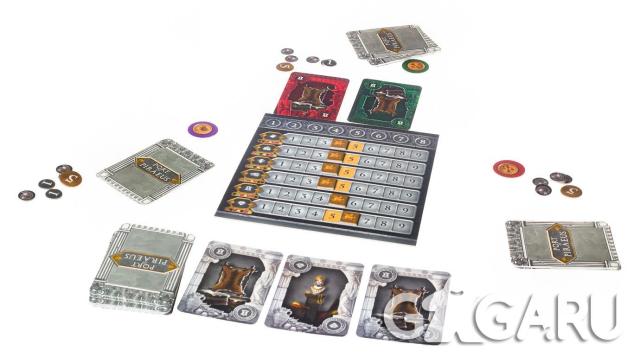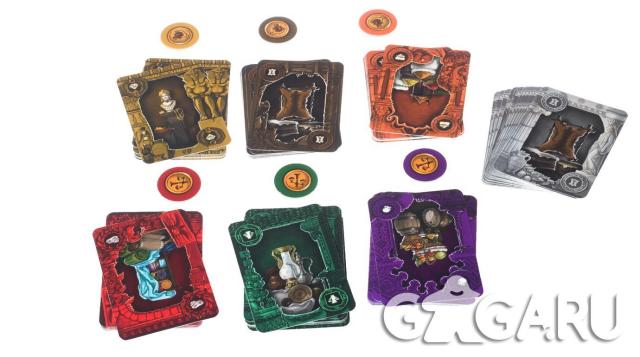Port of Piraeus
- Designer: Andrey Alexandrov
- Publisher: GaGa Games
- Players: 3-6
- Ages: 12+
- Time: 30-60 minutes
In the economic game Port of Piraeus, you are one of many prudent and provident merchants who have come to the Port of Piraeus from all over the world to sell their goods and purchase overseas items. Every decision you make will inevitably influence the market and either simplify or complicate the game for your opponents. Act carefully, trade proficiently and become the most successful merchant in the Port of Piraeus!
Players become merchants from different countries who are trying to make money buying and selling different commodities. There are eight trading days in the game, and each day players get to choose whether they want to buy other merchants’ products or sell their own. The prices for different products will keep changing depending on the situation. When they arrive back home, each merchant will get a good price for all the goods they buy here!
The game centers around the price board – here there are price tracks for the 6 different commodities in the game. Each commodity starts with a value of 5 – but the prices can vary from 1 to 9 throughout the game. Each player chooses one of the countries to play, and takes the deck of 8 goods for that country – each different country has a different distribution of the goods that it sells. The Greek cards are also set aside near the board; no one can choose to be the Greeks – but the locals of Piraeus will also add their contribution to the market each round.
The game is played over 8 rounds – you can keep track of this at the top of the market board. There are 5 phases in each round
- Setup – set the top 3 Greek goods cards next to the table. If the deck is empty, no cards are flipped up.
- Planning – each player takes his double sided token and decides if he is going to be a seller or a buyer this round. When all players have secretly chosen, they are simultaneously revealed. The market is then modified based on the results.
If there are more sellers than buyers, the price of each of the commodities on the Greek goods cards is reduced by one. If one card is present more than once, its price is reduced more than once as well.
If there are more buyers than sellers, the price of each of the commodities on the Greek goods cards is increased by one. If one card is present more than once, its price is increased more than once as well.
If there is a tie between buyers and sellers, the price of each of the commodities on the Greek goods cards is increased by one AND each of the commodities NOT seen on the Greek goods cards is decreased by one.
- Displaying more goods – now each player who chose to be a seller this round is able to choose zero to two goods from this hand (the cards he took at the start of the game) to add to the display. When all sellers have chosen their cards, they are revealed simultaneously. Now more price manipulation happens.
The price of each good for sale is decreased by one for each good of this type for sale, and the price for each good NOT for sale this round is increased by one. In all of these changes, note that the price cannot be less than 1 nor more than 9.
- Negotiation and Selling – now the buyers get a chance to buy cards, up to three cards total in this phase. The buyers place their marker on any card they wish to buy. It is possible for multiple markers to be on the same card. Once all players have placed their marker, the cards are sold. If a goods card only has one marker on it, the buyer pays the money – current cost in the market – to the seller (or the bank in the case of a Greek good) and takes the goods card to put in his bought pile. If there are multiple markers on a card, the competing buyers then have a closed fist auction for the card with the minimum bid being the price for the good in the market. The player with the highest bid takes the card. If there is a tie, no one buys the card this round. The action happens twice more so that each buyer has up to three chances to get a card.
- Cleanup – All unsold Greek goods are replaced on the bottom of the deck. All unsold player goods are sold for the current market price and then these cards are discarded from the game. The day marker is moved forward one space and then the next round begins.
The game ends at the end of the 8th trading day. At this point, all players look at the cards that they have purchased over the course of the game. You would like to get them into sets of at least three cards. A set can be made of cards of all one type (all spices) or can be cards of all one nationality (all Egyptian cards).
Sets are worth a lot of points
- 3 card set = 27 coins
- 4 card set = 40 coins
- 5 card set = 55 coins
- 6 card set = 70 coins
All unmatched foreign cards are worth 6 coins each.
Finally, all of your own cards (if you have any left from the start) are worth 1 coin each.
The player with the highest coin total wins the game.
My thoughts on the game
I’ve played the game a few times now, and to honest, I’m not sure what I think of it. I still haven’t quite grasped how the market prices are going to shift in the game, so it’s hard for me to make an effective plan. The double movement of prices ensures that game state is always in flux. I do wish that the game came with a player aid or maybe have had a slightly larger board with the price changing instructions on them; because we find that we’re always having to keep the rulebook open to the page telling us what happens to the prices in phases 2 and 3. The fact that none of us could remember the rules after two games underlines the difficulty of developing a good game plan in the game. I am still surprised at least once or twice a game when the price of a particular good is nowhere close to where I expected it to end up at the end of a round.
Once you get past the movement of prices, it’s an economic set collection game. Obviously, you’d like to buy low and sell high with the goods. It’s in your best interest to sell your cards because they are each only worth 1 coin at the end of the game, so getting rid of them helps increase your score. It also gives you coins that you can then use to buy other cards.
You definitely need to pay attention to the cards that other players offer. Each country has its own specific set of goods that it sells, and knowing what people sell may help you decide when you want to try to be a buyer. i.e. if you see that one of your opponents only has a few coins, it is likely that he will be a seller this round to try to gain coins to buy in a future round. If you know that you want one of the goods that his country produces, then maybe it’s time this turn to buy.
Competition can be fierce for the Greek cards – they can be used to complete sets, and as there are three available each round, it’s possible to buy up a 27 point set in a single turn if no one else opposes you for the Greek cards… They can also be used to finish off a set of a single commodity. There are 18 Greek cards, so there are three for each particular good in the game.
In most of our games, players end up taking 4 turns as a seller (in order to divest themselves of all 8 of their starting cards) and 4 turns as a buyer. You can control the timing of when you buy and sell, but with the wild swings in commodity prices, I have found it quite difficult to predict when I’m going to be successful at either. (To be fair, this isn’t necessarily a weakness of the game – it could simply be that I just haven’t been able to grok the game.)
The game seems to be a solid game with some room for clever play, but I’ll admit that I haven’t been able to grasp it well in my initial plays. The end result of all of the price manipulations gives the game an overriding feeling of “fiddliness” moreso than “economic” or “set collecting”. I have printed out the price movement rules on small cards so that all players can have a copy of it in front of them if we play again – but it’ll have to be when someone else suggests to play the game.
Thoughts from other Opinionated Gamers
Dan Blum (1 play): It’s not terrible, but it has problems. As Dale notes, because your own cards are only worth 1 point at the end and you get at least that much if you sell them (and almost certainly more), you will want to sell on half the turns. (You also need the money to buy other cards, of course.) So it boils down to timing your selling turns vs. your buying turns and which goods to sell when, but the pricing changes are chaotic enough that you can’t do too much planning here. You can do some, but it seems likely that a lot of games will come down to who was lucky enough to sell a few goods for 1-2 more.
If I were to play again I would definitely want a reference card showing which players had which goods, and if playing with 3-4 would insist on having a balanced setup (so no one has an overall rarer set of goods than the others). With 5 players a balanced setup is impossible.
Ratings from the Opinionated Gamers
- I love it!
- I like it.
- Neutral. Dale Y, Dan Blum
- Not for me…




